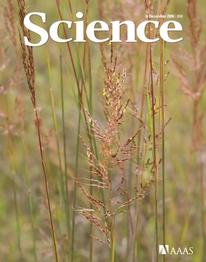COVER: The grass Sorghastrum nutans, one of a dozen plant species that dominate native North American prairies. Biofuels produced from diverse mixtures of prairie plants can provide greater energy yields and environmental benefits than food-based biofuels such as corn ethanol and soybean biodiesel. From Tilman et al. (2006) Photo: Jason Hill
COVER: The U.S. Renewable Fuel Standards require increasing amounts of biofuels be produced annually through 2022. This issue's feature article compares visions from three federal agencies of how and where the biomass needed to meet these goals might be grown. The cover shows two perennial grasses, big bluestem (Andropogon gerardii) and Miscanthus (Miscanthus x giganteus), currently being explored as biofuel feedstocks. From Keeler et al. (2013) Photos: Jason Hill
Moore, K., S. Birrell, R. Brown, M. Casler, J. Euken, H. Hanna, D. Hayes, J. Hill, K. Jacobs, C. Kling, D. Laird, R. Mitchell, P. Murphy, R. Raman, C. Schwab, K. Shinners, K. Vogel, J. Volenec (2014) Midwest vision for sustainable fuel production. Biofuels 5 :687–702. DOI: 10.1080/17597269.2015.1015312.
Tessum, C., J. Hill, and J. Marshall (2014) Life cycle air quality impacts of conventional and alternative light duty transportation in the United States. Proc. Natl. Acad. Sci. USA 111: 18490–18495. DOI: 10.1073/pnas.1406853111.
Hill, J. (2013) Life cycle analysis of biofuels. In Levin, S. (ed.) Encyclopedia of Biodiversity, Vol. 4. Elsevier, Amsterdam.
Keeler B., B. Krohn, T. Nickerson, J. Hill (2013) U.S. Federal agency models offer different visions for achieving Renewable Fuel Standard (RFS2) biofuel volumes. Environ. Sci. Technol. 47: 10095–10101.
Heimpel G., Y. Yang, J. Hill, D. Ragsdale. (2013) Environmental consequences of invasive species: Greenhouse gas emissions of insecticide use and the role of biological control in reducing emissions. PLOS ONE. DOI: 10.1371/journal.pone.0072293.
Chum H., Y. Zhang, J. Hill, D. Tiffany, R. Morey, A. Goss Eng, Z. Haq. (2013) Understanding the evolution of environmental and energy performance of the US corn ethanol industry: evaluation of selected metrics. Biofpr. DOI: 10.1002/bbb.1449.
Tessum, C., J. Marshall, and J. Hill (2012) A spatially and temporally explicit life cycle inventory of air pollutants from gasoline and ethanol in the United States. Environ. Sci. Technol. 46: 11408–11417. DOI: 10.1021/es3010514.
Davis, A., J. Hill, C. Chase, A. Johanns, and M. Liebman (2012) Increasing cropping system diversity balances productivity, profitability, and environmental health. PLOS ONE. DOI: 10.1371/journal.pone.0047149.
Millet, D., E. Apel., D. Henze, J. Hill, J. Marshall, H. Singh, and C. Tessum (2012) Natural and anthropogenic ethanol sources in North America and potential atmospheric impacts of ethanol fuel use. Environ. Sci Technol. 46: 8484–8492. DOI: 10.1021/es300162u.
Wagstrom, C., and J. Hill (2012) Air pollution impacts of biofuels. In Gasparatos, A., and P. Stromberg (eds.) Socioeconomic and Environmental Impacts of Biofuels: Evidence from Developing Nations. Cambridge University Press, England.
Tilman, D., C. Balzer, J. Hill, and B. Befort (2011) Global food demand and the sustainable intensification of agriculture. Proc. Natl. Acad. Sci. USA 108: 20260–20264. DOI: 10.1073/pnas.1116437108.
O’Hare, M., M. Delucchi, M. Edwards, U. Fritsche, H. Gibbs, T. Hertel, J. Hill, D. Kammen, D. Laborde, L. Marelli, D. Mulligan, R. Plevin, and W. Tyner (2011) Comment on “Indirect land use change for biofuels: Testing predictions and improving analytical methodologies”. Biomass and Bioenergy 35: 4485–4487.
Foley, J., N. Ramankutty, C. Balzer, E. Bennett, K. Brauman, S. Carpenter, E. Cassidy, J. Gerber, J. Hill, M. Johnston, C. Monfreda, N. Mueller, C. O’Connell, S. Polasky, D. Ray, J. Rockström, J. Sheehan, S. Siebert, D. Tilman, P. West, and D. Zaks (2011) Solutions for a cultivated planet. Nature 478: 337–342.
Wiens, J., J. Fargione, and J. Hill (2011) Biofuels and biodiversity. Ecol. Appl. 21: 1085–1095.
Fargione, J., R. Plevin, and J. Hill (2010) The ecological impact of biofuels. Ann. Rev. Ecol. Evol. Syst. 41: 351–357.
Davis, A., R. Cousens, J. Hill, R. Mack, D. Simberloff, and S. Raghu (2010) Preventing biofeedstock invasions before they occur: A call to action. Front. Ecol. Environ. 8: 533-539.
Hill, J. (2009) Opportunities and challenges of transitioning to sustainable next-generation transportation biofuels. Int. J. Biotechnology 11: 5–13.
Fargione, J., T. Cooper, D. Flashpohler, J. Hill, C. Lehman, T. McCoy, S. McLeod, K. Oberhauser, and D. Tilman (2009) Bioenergy and wildlife: Threats and opportunities for grasslands. Bioscience 59: 767–777.
Tilman, D., R. Socolow, J. Foley, J. Hill, E. Larson, L. Lynd, S. Pacala, J. Reilly, T. Searchinger, C. Somerville, R. Williams (2009) Beneficial biofuels – The food, energy, and environment trilemma. Science 325: 270–271.
Hill, J., S. Polasky, E. Nelson, D. Tilman, H. Huo, L. Ludwig, J. Neumann, H. Zheng, and D. Bonta (2009) Climate change and health costs of air emissions from biofuels and gasoline. Proc. Natl. Acad. Sci. USA 106: 2077–2082.
Fargione, J., J. Hill, D. Tilman, S. Polasky, and P. Hawthorne (2008) Land clearing and the biofuel carbon debt. Science 319: 1235–1238.
Hill, J. (2007) Environmental costs and benefits of transportation biofuel production from food- and lignocellulose-based energy crops. A review. Agron. Sust. Dev. 27: 1–12.
Tilman, D., J. Hill, and C. Lehman (2006) Carbon-negative biofuels from low-input high-diversity grassland biomass. Science 314: 1598–1600.
Hill, J., E. Nelson, D. Tilman, S. Polasky, and D. Tiffany (2006) Environmental, economic, and energetic costs and benefits of biodiesel and ethanol biofuels. Proc. Natl. Acad. Sci. USA 103: 11206–11210.

